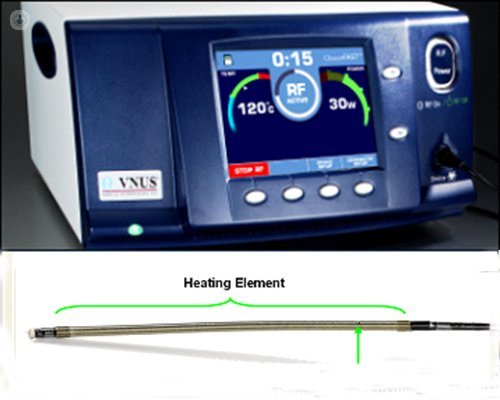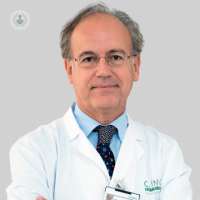Advantages of Radiofrequency to remove varicose veins
Written by:Chronic venous insufficiency has a high incidence in the current western population. Varicose veins of the lower limbs are the most frequent vascular problem, affecting 20-25% of women and 10-15% of men. Surgical treatment in uncomplicated symptomatic varices is effective.
To achieve effective and long-lasting results in the treatment of varicose veins, it is essential to eliminate the origin of venous reflux. In 70% of cases, varices of the lower extremities have their origin in the circulatory insufficiency of the internal saphenous vein. For this reason, the irrigation of this vein is usually the first therapeutic target. To treat venous hypertension, the only effective and long-lasting treatment has been for years the ligation of the sapheno-femoral shaft and stripping of the VSI. But in the last decade the medical and technological development has allowed the implication of new minimally invasive techniques such as the VNUS Closure (RFA) or endolaser endovenous radiofrequency.
Radiofrequency to treat varicose veins
Radiofrequency consists of electric and magnetic waves that when they come into contact with a fabric produce vibration and friction in their atoms, transforming themselves into thermal energy that raises the temperature. This causes the desired effects in the vein to be treated:
- Endoletial destruction
- Denaturation and contraction of collagen
- Shortening and thickening of the venous wall
- Reduction of vessel light
In short, it manages to make the varicose vein disappear by arthrophy. Radiofrequency has proven to be an effective treatment with ultrasound success and high patient satisfaction.
Treatment of varicose veins: radiofrequency vs stripping
Various analyzes have been performed with variceal patients to compare the efficacy of radiofrequency with stripping, prior art. In the comparisons it has been shown that radiofrequency offers equally effective results, faster and with a shorter recovery time. Stripping on the other hand offered greater morbidity figures weeks after treatment, especially in the occurrence of bruising, schistosis and pain.
The efficacy of both techniques was again compared two years after treatment, and in both cases the efficacy is long lasting, with a lower rate of recurrence for radiofrequency (14%) than for stripping (21%).
We also compared the minimally invasive radiofrequency technique with conventional varicose vein surgery, and the results showed a clear advantage for radiofrequency: shorter intervention time, less pain, less schizoaemia and less recovery time to return to the work routine.
Remove varicose veins: Radiofrequency vs endolaser
The two minimally invasive techniques for treating varicose veins have also been compared in patients. Both the endolaser and the radiofrequency have demonstrated high success rates, with 100% effectiveness in the endolaser and 96% in the radiofrequency. Regarding the complications derived from the treatment, the endolaser had a higher rate of complications (20.8%) compared to radiofrequency (7.6%), although both rates were very low. Other clinical research revealed that radiofrequency is slightly better in terms of recovery and postoperative than endolaser, and the latter had a higher rate of complications.
Other subsequent studies also analyzed other values such as the time of reincorporation to the working day or the quality of life after the intervention, obtaining similar results with some advantage for the radiofrequency. In general, it can be concluded that the radiofrequency presents similar results to the endolaser, with less pain, hematomas and ecchymoses, besides a better quality of life in the short term.
Radiofrequency procedure to eliminate varicose veins
The intravenous radiofrequency ablation intervention uses an RFG generator and a ClosureFast catheter, a device that improves efficacy and reduces the ablation time of the previous option.
The procedure of removal of varicose veins with radiofrequency is totally eco-assisted. Prior to the intervention, an echo-Doppler marking should be performed from the groin to the ankle to indicate the stretches with complications.
The procedure requires the use of tumescent local anesthesia, that is, by the eco-guided injection of Klein's solution at perivenous level. It is carried out with this anesthesia with a triple purpose:
- Protects skin and nearby structures from the heat of radiofrequency
- Analgesia
- Favor the collapse of the veins
Access to the varix to be treated may be surgical through a small incision or percutaneous by the technique of Seldinger.
At the end of the intervention, the echocardiographer should follow the ultrasound examination of the treated area, as well as a control with Eco-Doppler the first few days after treatment to rule out possible complications.

Radiofrequency, the best treatment for varicose veins
Intravenous radiofrequency ablation VNUS Closure FAST is currently a technique that has proven to be safe and effective in the removal of varicose veins, with high patient satisfaction. With a faster recovery time, it allows to incorporate before the normal routine and has no bruising or pain.
Radiofrequency has demonstrated its superiority over previous treatments, as well as before the endolaser, the other most common minimally invasive treatment option for varicose veins.
Complications such as venous thrombosis, skin burns, and neuritis with this technique are very uncommon. However, in order to prevent them, the patient should be placed in the hands of an experienced angiologist with experience in techniques such as infiltration of tumescent anesthesia or echo-Doppler, which is essential for an optimal procedure and correct follow-up of the patient after treatment.


